World’s First Mushroom-Powered Waterless Toilet Turns Human Waste into Fertilizer
The University of British Columbia (UBC) has launched the world’s first mushroom-powered waterless toilet, introducing a groundbreaking solution that could revolutionize sustainable sanitation practices globally. This innovative technology utilizes the power of mushrooms to break down human waste, transforming it into nutrient-rich fertilizer that can be used to enrich soil and promote plant growth. By harnessing the natural decomposition abilities of mushrooms, this eco-friendly toilet not only eliminates the need for water in the flushing process but also addresses the critical issue of waste management in a sustainable and resourceful manner.
Traditional flush toilets consume significant amounts of water with each use, contributing to water scarcity and environmental pollution. In contrast, the mushroom-powered waterless toilet operates without the need for water, making it an ideal solution for water-stressed regions and off-grid communities. This technology not only conserves water but also reduces the energy and costs associated with conventional sewage treatment systems. By converting human waste into valuable fertilizer, it closes the nutrient loop and promotes circular economy principles, turning a potential environmental hazard into a valuable resource.
The key to the functionality of the mushroom-powered toilet lies in the mycelium, the root structure of fungi that has the remarkable ability to decompose organic matter. Within the toilet system, specially selected mushroom mycelium break down the waste material, converting it into byproducts that are safe and beneficial for the environment. As the mycelium digest the waste, they produce enzymes that help break down complex molecules into simpler forms, releasing nutrients that can nourish the soil. This process not only eliminates pathogens and odors from the waste but also creates a valuable end product that can support agricultural productivity.
Moreover, the use of mushroom mycelium in waste treatment offers a sustainable alternative to chemical-based sanitation methods. Unlike traditional sewage treatment processes that rely on energy-intensive technologies and harsh chemicals, mushroom-powered toilets provide a natural and environmentally friendly approach to waste management. By harnessing the biological processes of fungi, this innovative technology demonstrates the potential for nature-based solutions to address complex challenges such as sanitation and resource recovery.
In addition to its environmental benefits, the mushroom-powered waterless toilet also has the potential to empower communities by providing them with a means to manage their waste locally and sustainably. In regions where access to sanitation infrastructure is limited, this technology offers a decentralized solution that can improve public health outcomes and enhance overall quality of life. By enabling communities to close the loop on waste management and create valuable resources from human waste, the mushroom-powered toilet promotes self-sufficiency and resilience in the face of environmental challenges.
As the world continues to face pressing issues related to water scarcity, pollution, and sustainable development, innovative solutions like the mushroom-powered waterless toilet represent a beacon of hope for a more sustainable future. By reimagining the way we approach sanitation and waste management, this technology showcases the potential of nature-inspired design to address complex environmental problems effectively. With further research and implementation, mushroom-powered toilets could play a significant role in promoting sustainable practices and fostering a circular economy mindset on a global scale.
In conclusion, the world’s first mushroom-powered waterless toilet developed by the University of British Columbia heralds a new era in sustainable sanitation practices. By harnessing the power of mushrooms to transform human waste into fertilizer, this innovative technology offers a holistic solution to the challenges of water scarcity, pollution, and resource management. As we strive to build a more sustainable and resilient future, the mushroom-powered toilet stands out as a shining example of how nature-inspired design can lead to impactful innovations with far-reaching benefits for both people and the planet.
mushroom-powered toilet, sustainable sanitation, waste management, environmental innovation, circular economy












